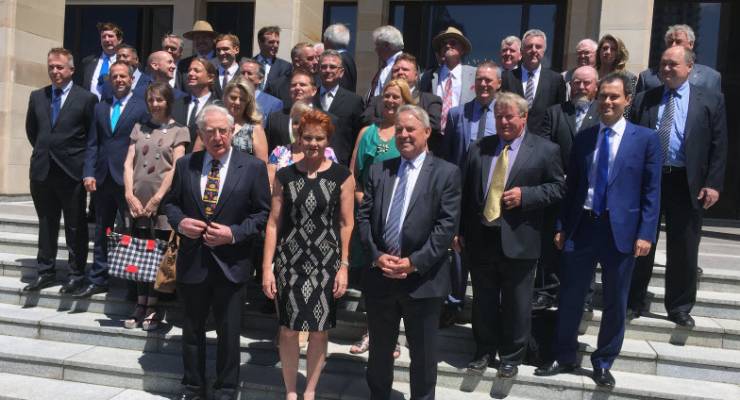
If there’s truth to this morning’s reports that the Liberal Party and One Nation are poised to strike a preference deal ahead of the Western Australian state election on March 11, a new milestone will have been reached in the slow disintegration of Australia’s two-party system.
For a period lasting from around 2001 until the middle of last year, it was possible to imagine that Australia had somehow escaped an anti-immigration politics that was emerging in a variety of guises in Europe, courtesy of the Le Pen family in France, Pim Fortuyn followed by Geert Wilders in the Netherlands, and the British National Party followed by UKIP in the United Kingdom.
Pauline Hanson looked for all the world like a distinctively Australian incarnation of this phenomenon when she arrived on the scene in 1996, but she would shortly prove to be a flash in the pan — her own seat in the federal parliament was lost at the 1998 election, and her party had little left to show for itself three years later.
The black armband view of this development was that John Howard had achieved Hansonism by stealth through his exploitation of the Tampa episode.
Whatever the reason, there was no immediate relapse at the end of the Howard era — the 2007 election was as dominated by the major parties as any federal election had been since the Keating-versus-Hewson clash of 1993, and when pox-on-both-houses sentiment again became the order of the day in 2010, the main beneficiary was the Greens.
The major party establishment, it seemed, had seen off the threat — partly through cultural appropriation with respect to asylum seeker policy, but also through the uniquely Australian expedient of preference dealing.
The question of whether or not One Nation should be cut in on preferences was, at first, a matter of bitter controversy within the Coalition parties, but the defeat of Rob Borbidge’s Coalition government in 1998 caused an initially hesitant John Howard to resolve the matter in favour of following Labor’s lead and putting the party last.
That was enough to cost Hanson her bid for re-election in 1998, and it also meant the party needed something approaching a quota in its own right to win seats in the Senate, without help from the major party surpluses available to the Australian Democrats and the Greens.
In fairly short order, One Nation was reduced to fringe party status, and Hanson was left to eke out the diminishing returns of her fading celebrity by any means available.
Needless to say, it’s a very different story today, and not just because of Malcolm Turnbull’s tactical clanger of calling a double dissolution after diminishing the parties’ power to shepherd their preferences in the desired direction.
At both state and federal level, opinion polls are consistently showing One Nation gouging support from the Coalition.
As far as Coalition strategists are concerned, the only thing for it is to accept a relationship with One Nation that parallels the one Labor has long had with the Greens.
In preparation for this eventuality, conservative politicians have been greasing the wheels by arguing that One Nation is “not the party it was 20 years ago” (WA Premier Colin Barnett), and that conservatives should not be “lectured by Labor about preference deals” given their own arrangements with the no-less-extremist Greens (Queensland Opposition Leader Tim Nicholls).
Given that ballot paper studies have shown nearly half of Liberal voters follow their party’s how-to-vote card, this promises to be a game-changer for One Nation in seats where the Liberals do poorly enough to drop out of the count.
However, it’s less clear how much a benefit the Liberals stand to gain in return.
Certainly, One Nation preferences can still make a big difference in Western Australia’s upper house, which still has the group ticket voting system that was abolished for the Senate last year.
But last year’s results from the House of Representatives were, from the perspective of the Liberals’ preference ambitions, rather less auspicious.
One Nation contested 15 seats — 12 in Queensland, three in New South Wales — and directed preferences to Labor in one (the Hunter region seat of Paterson) and the Liberal National Party in another (Pauline Hanson’s old Ipswich-based stamping ground of Oxley), with “split tickets” offered in the other 13.
After allowing for the tendency of preferences to flow more strongly to the dominant major party in any given electorate, One Nation preferences divided fairly evenly where there was a split ticket, while a preference direction increased the share of preferences for the beneficiary by around 8%.
In a typical electorate, this suggests a preference deal stands to benefit the Liberals by around 1% on the two-party preferred vote.
Elections are not often won and lost on such margins, but the Liberals will be calculating that any win they might manage to eke out in WA will have to be a narrow one.
This is borne out by a Labor-commissioned ReachTEL poll published today in The West Australian, which suggests the Liberals are headed for a devastating defeat in the bellwether northern suburbs seat of Joondalup — in no small part due to a 70% flow of minor party and independent preferences to Labor.








Thanx for this. Too close an association with the Coalition may reduce One Nation’s attractiveness to former Labor voters.
If it is ‘Needless to say’ then don’t say it, and even better, don’t write it.